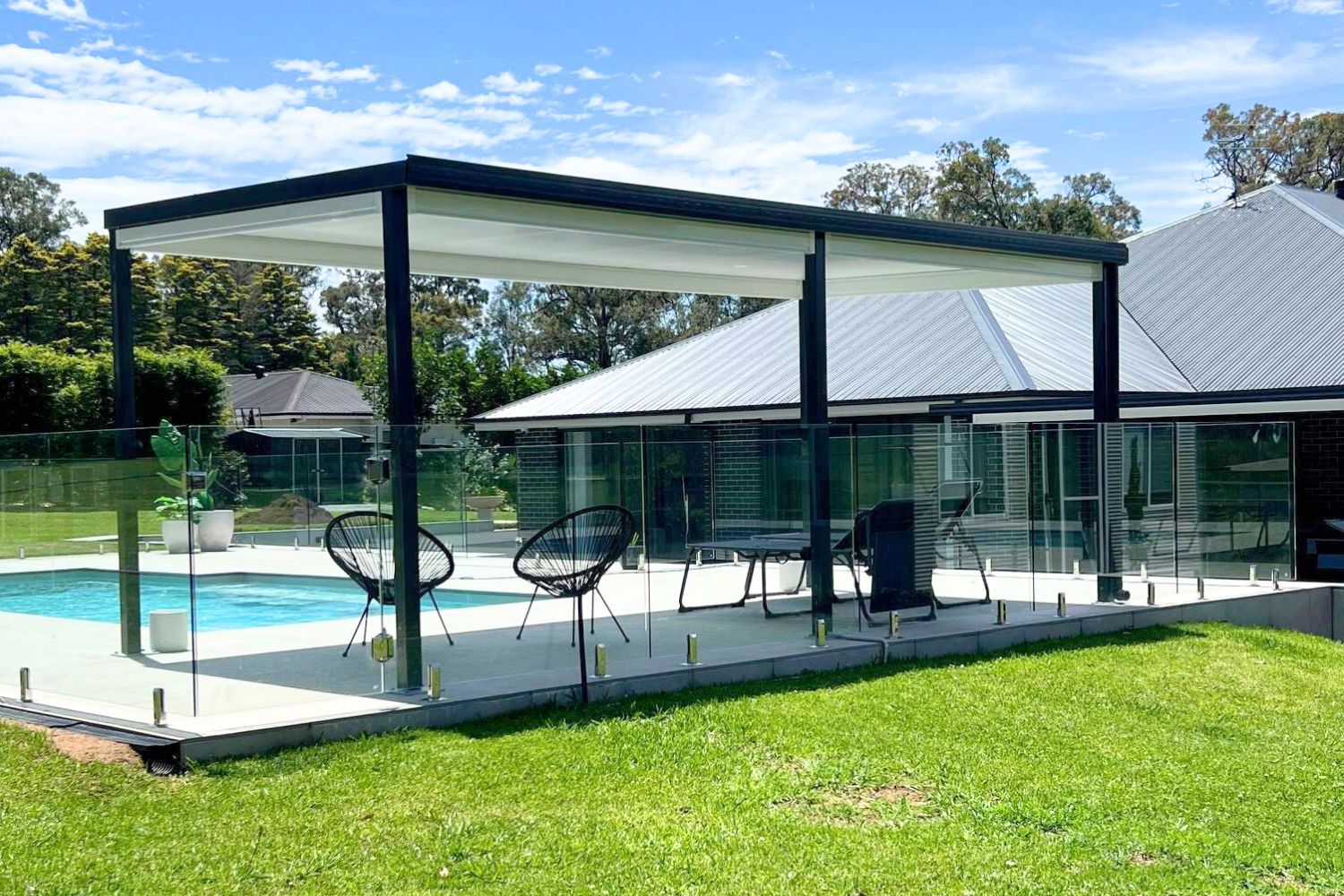Building your own pergola transforms any outdoor space into a functional entertainment area that’s perfect for golden afternoons and weekend gatherings. With Australia ranking 7th among the top ten DIY markets globally by revenue, more homeowners are embracing DIY pergola projects as an affordable way to enhance their entertainment areas.
Your space. Your kit. Your call. This comprehensive guide covers everything you need to know about DIY pergolas in Australia, from choosing the right materials, to understanding building regulations and achieving professional results with custom solutions.
Understanding Pergola Basics: What Makes a Quality Structure
A pergola is an outdoor framework consisting of vertical posts supporting crossbeams and an open lattice roof. Unlike enclosed structures, pergolas provide partial shade while maintaining airflow and creating defined entertainment areas. The key to a successful DIY pergola lies in understanding the fundamental components and choosing quality materials that suit Australian conditions.
Modern pergolas serve multiple purposes beyond basic shade provision. They create outdoor rooms for entertaining, support climbing plants, define landscaping boundaries, and significantly increase property value. When properly designed and built, a quality pergola becomes an extension of your home’s living space.
Essential DIY Pergola Components and Terminology
Understanding pergola terminology helps you make informed decisions about your project. The basic structure includes several key elements that work together to create a stable, attractive outdoor feature.
Structural Elements:
- Posts: Vertical support columns that carry the entire structure’s weight
- Beams: Horizontal supports that span between posts
- Brackets: Hardware connecting beams to posts for added strength
Roof Options:
- Flat roof: Clean, modern design with excellent drainage and weather protection
- Gable roof: Traditional pitched design for enhanced weather shading and visual appeal
- Cantilever: Extends beyond support posts for maximum coverage without obstructing space
Roofing Materials:
- Classic: Standard COLORBOND® steel roofing for reliable weather protection
- Premium: Enhanced COLORBOND® steel with superior finish and durability
- Insulated: Superior thermal performance with downlight compatibility for year-round comfort
Building Regulations and Council Requirements in NSW
Before starting your DIY pergola project, understanding NSW building regulations ensures compliance and avoids costly mistakes. According to NSW Government guidelines, pergolas can be built as exempt development if they meet specific criteria. Council requirements can vary, so it’s best to check your local council’s regulations or contact them directly to confirm what’s needed for your area.
Additional Considerations:
- Obtain written consent from neighbours if building closer to boundary fences
- Ensure structural adequacy according to manufacturer specifications
- Connect roof drainage to existing stormwater systems
Professional engineering certification may be required for larger structures or challenging site conditions.
Material Choices: Steel vs Aluminium
Choosing the right material significantly impacts your pergola’s durability, maintenance requirements, and overall cost. Each material offers distinct advantages depending on your priorities and local conditions.
Steel Pergolas: Superior Durability Steel pergolas are turning heads due to their proven performance and sought-after aesthetic, requiring minimal upkeep while being incredibly durable. COLORBOND® steel, specifically designed for Australian conditions, provides exceptional weather resistance and comes with manufacturer warranties of up to 25 years.
Steel advantages include superior strength for larger spans, resistance to warping and splitting, and excellent fire resistance. The material’s durability means lower long-term costs despite higher initial investment.
Aluminium Pergolas: Lightweight Versatility Aluminum has the best price to performance ratio when building pergolas that last a lifetime, being resistant to rot, rust, and fading while requiring low maintenance. Aluminium’s lightweight nature makes it ideal for DIY installation, though proper anchoring is essential in windy locations.
For Australian conditions, steel and aluminium pergolas provide the best long-term value, handling extreme temperatures, UV exposure, and weather variability.
Custom Kit Advantages: Why One Size Doesn’t Fit All
Standard pergola sizes rarely match real-world requirements. Custom pergola kits solve this problem by adapting to your exact space, ensuring perfect fit without waste or compromise.
Design Flexibility: Custom solutions accommodate any block size, architectural style, or specific requirements. Whether you need cantilever designs for limited space, insulated roofing for year-round comfort, or specific colour coordination with existing structures, custom kits deliver precise solutions.
Quality Assurance: Unlike generic kits with limited options, custom solutions use professional-grade materials with certified engineering calculations. Every component is sized specifically for your project, eliminating guesswork and ensuring structural integrity.
Complete Solutions: Quality custom pergola kits include everything needed for successful installation: pre-cut materials, detailed instructions, all necessary hardware, and technical support when questions arise. This comprehensive approach eliminates multiple supplier coordination and ensures component compatibility.
DIY Installation: Tools, Techniques, and Timeline
Successful DIY pergola installation requires proper planning, appropriate tools, and realistic timeline expectations. Most custom pergola kits can be installed by competent DIYers with basic construction skills.
Essential Tools:
- Spirit level and laser level for accurate alignment
- Power drill with various bit sizes
- Circular saw or angle grinder for final adjustments
- Socket set for bolt connections
- Measuring tape and chalk line for marking
- Personal protective equipment
Installation Process:
- Site preparation: Clear and level the installation area
- Foundation work: Install concrete footings or anchor points
- Post installation: Erect vertical supports with proper alignment
- Beam attachment: Connect horizontal supports using specified brackets
- Roof installation: Install beams and any roofing materials
- Final checks: Verify all connections and structural stability
Timeline Expectations: Most standard pergola installations take 1-2 weekends for experienced DIYers. Larger or more complex designs may require additional time. Factor in concrete curing time if installing new footings, and consider weather conditions that might affect the schedule.
Maximising Your Investment: Design Considerations
Smart design choices enhance both functionality and property value. Consider how your pergola integrates with existing outdoor spaces and future entertainment needs.
Orientation and Positioning: Position your pergola to maximise afternoon shade while maintaining morning sun access. Consider prevailing wind patterns and privacy requirements when determining placement and height.
Integration Opportunities: Connect your pergola to existing structures like decks, patios, or pool areas for seamless outdoor living flow. Ensure adequate drainage and access to utilities if planning to add lighting, ceiling fans, or outdoor kitchens.
Future Enhancements: Design with expansion in mind. Quality pergola structures can support additional features like outdoor blinds, heating elements, or climbing plant supports without compromising structural integrity.
Professional Support: When to Seek Expert Advice
While DIY installation is achievable for most pergola projects, certain situations benefit from professional consultation or assistance.
Engineering Requirements: Challenging sites with slope, poor soil conditions, or proximity to existing structures may require engineering assessment. Large spans or unusual designs also benefit from professional structural verification.
Electrical Integration: Adding lighting, ceiling fans, or other electrical features requires licensed electrician involvement. Plan electrical requirements during initial design to avoid retrofitting challenges.
Complex Installations: Multi-level sites, integration with existing rooflines, or custom architectural features may exceed typical DIY capabilities. Professional installation ensures optimal results while maintaining warranty coverage.
Maintenance and Longevity: Protecting Your Investment
Quality pergolas require minimal maintenance when built with appropriate materials and proper installation techniques. Understanding maintenance requirements helps maximise your structure’s lifespan.
Steel and Aluminium Maintenance:
- Annual cleaning with mild detergent removes dirt and pollutants
- Inspect fasteners and connections for any loosening
- Check drainage systems remain clear and functional
- Touch up any scratches to prevent corrosion
Preventive Care: Regular maintenance extends any pergola’s lifespan significantly. Address minor issues promptly to prevent major repairs later.
Cost Considerations and Value Addition
DIY pergola installation offers substantial savings compared to full professional construction while delivering comparable results with quality materials and proper techniques.
Budget Planning: Custom pergola kits typically cost 30-50% less than complete professional installation while providing the same materials and engineering. Factor in tool purchase or rental costs if not already owned.
Value Addition: Well-designed pergolas increase property value by creating additional living space and enhancing outdoor entertainment capabilities. Quality materials and professional appearance maximise this return on investment.
Long-term Savings: Choosing durable materials like steel or aluminium eliminates ongoing maintenance costs associated with timber options. Higher initial investment delivers better long-term value through reduced replacement and repair requirements.
Getting Started: Your Next Steps
Ready to transform your outdoor space with a quality DIY pergola? Success starts with proper planning and choosing the right materials for your specific requirements.
Begin by measuring your available space and considering how you’ll use your new outdoor area. Research local council requirements and factor any approval processes into your timeline. Choose materials that match both your budget and long-term expectations for durability and maintenance.
Quality custom pergola kits provide the foundation for successful DIY projects, combining professional engineering with DIY-friendly installation processes. With proper planning, appropriate materials, and realistic expectations, your pergola project will create an outdoor entertainment space that enhances your lifestyle for decades to come.
Your outdoor dreams deserve quality solutions that fit perfectly and last indefinitely. Made to fit, built to last – that’s what separates successful pergola projects from disappointing compromises.

